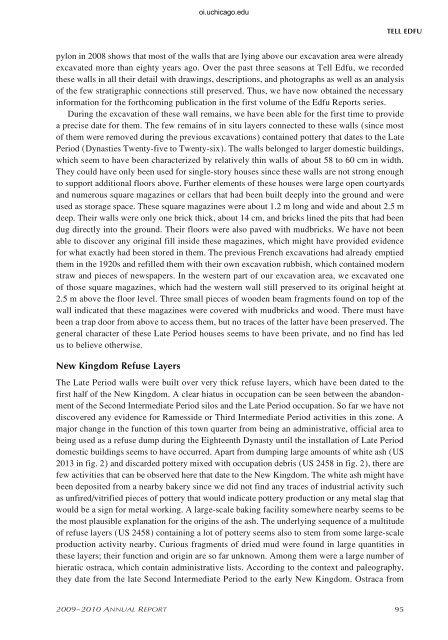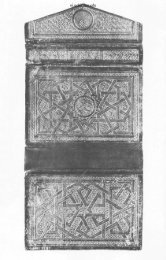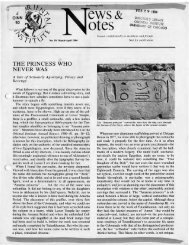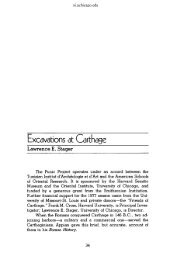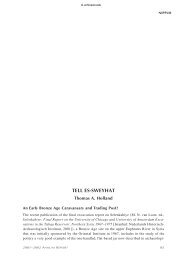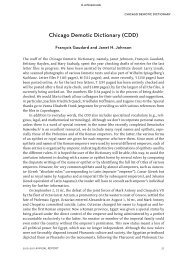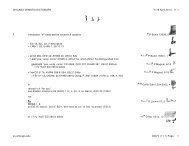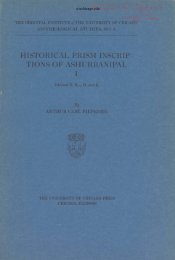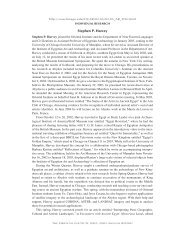TELL EDFU. Nadine Moeller - Oriental Institute - University of Chicago
TELL EDFU. Nadine Moeller - Oriental Institute - University of Chicago
TELL EDFU. Nadine Moeller - Oriental Institute - University of Chicago
Create successful ePaper yourself
Turn your PDF publications into a flip-book with our unique Google optimized e-Paper software.
Tell edfu<br />
pylon in 2008 shows that most <strong>of</strong> the walls that are lying above our excavation area were already<br />
excavated more than eighty years ago. Over the past three seasons at Tell Edfu, we recorded<br />
these walls in all their detail with drawings, descriptions, and photographs as well as an analysis<br />
<strong>of</strong> the few stratigraphic connections still preserved. Thus, we have now obtained the necessary<br />
information for the forthcoming publication in the first volume <strong>of</strong> the Edfu Reports series.<br />
During the excavation <strong>of</strong> these wall remains, we have been able for the first time to provide<br />
a precise date for them. The few remains <strong>of</strong> in situ layers connected to these walls (since most<br />
<strong>of</strong> them were removed during the previous excavations) contained pottery that dates to the Late<br />
Period (Dynasties Twenty-five to Twenty-six). The walls belonged to larger domestic buildings,<br />
which seem to have been characterized by relatively thin walls <strong>of</strong> about 58 to 60 cm in width.<br />
They could have only been used for single-story houses since these walls are not strong enough<br />
to support additional floors above. Further elements <strong>of</strong> these houses were large open courtyards<br />
and numerous square magazines or cellars that had been built deeply into the ground and were<br />
used as storage space. These square magazines were about 1.2 m long and wide and about 2.5 m<br />
deep. Their walls were only one brick thick, about 14 cm, and bricks lined the pits that had been<br />
dug directly into the ground. Their floors were also paved with mudbricks. We have not been<br />
able to discover any original fill inside these magazines, which might have provided evidence<br />
for what exactly had been stored in them. The previous French excavations had already emptied<br />
them in the 1920s and refilled them with their own excavation rubbish, which contained modern<br />
straw and pieces <strong>of</strong> newspapers. In the western part <strong>of</strong> our excavation area, we excavated one<br />
<strong>of</strong> those square magazines, which had the western wall still preserved to its original height at<br />
2.5 m above the floor level. Three small pieces <strong>of</strong> wooden beam fragments found on top <strong>of</strong> the<br />
wall indicated that these magazines were covered with mudbricks and wood. There must have<br />
been a trap door from above to access them, but no traces <strong>of</strong> the latter have been preserved. The<br />
general character <strong>of</strong> these Late Period houses seems to have been private, and no find has led<br />
us to believe otherwise.<br />
New Kingdom Refuse layers<br />
oi.uchicago.edu<br />
The Late Period walls were built over very thick refuse layers, which have been dated to the<br />
first half <strong>of</strong> the New Kingdom. A clear hiatus in occupation can be seen between the abandonment<br />
<strong>of</strong> the Second Intermediate Period silos and the Late Period occupation. So far we have not<br />
discovered any evidence for Ramesside or Third Intermediate Period activities in this zone. A<br />
major change in the function <strong>of</strong> this town quarter from being an administrative, <strong>of</strong>ficial area to<br />
being used as a refuse dump during the Eighteenth Dynasty until the installation <strong>of</strong> Late Period<br />
domestic buildings seems to have occurred. Apart from dumping large amounts <strong>of</strong> white ash (US<br />
2013 in fig. 2) and discarded pottery mixed with occupation debris (US 2458 in fig. 2), there are<br />
few activities that can be observed here that date to the New Kingdom. The white ash might have<br />
been deposited from a nearby bakery since we did not find any traces <strong>of</strong> industrial activity such<br />
as unfired/vitrified pieces <strong>of</strong> pottery that would indicate pottery production or any metal slag that<br />
would be a sign for metal working. A large-scale baking facility somewhere nearby seems to be<br />
the most plausible explanation for the origins <strong>of</strong> the ash. The underlying sequence <strong>of</strong> a multitude<br />
<strong>of</strong> refuse layers (US 2458) containing a lot <strong>of</strong> pottery seems also to stem from some large-scale<br />
production activity nearby. Curious fragments <strong>of</strong> dried mud were found in large quantities in<br />
these layers; their function and origin are so far unknown. Among them were a large number <strong>of</strong><br />
hieratic ostraca, which contain administrative lists. According to the context and paleography,<br />
they date from the late Second Intermediate Period to the early New Kingdom. Ostraca from<br />
2009–2010 annual repOrT 95


